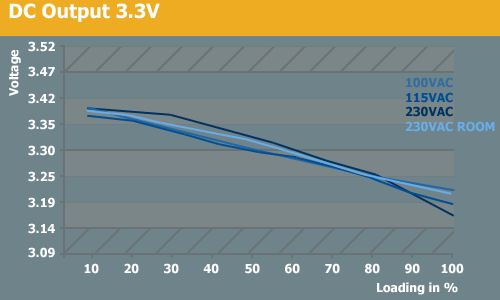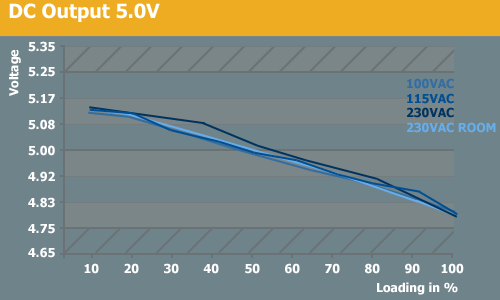The Enermax Liberty - Getting long in the tooth, but still worth a look
by Christoph Katzer on July 30, 2007 1:40 AM EST- Posted in
- Cases/Cooling/PSUs
Testing
As usual we are testing with our Chroma programmable loads to fully load each rail to a specific amount. This is important to get truly accurate results and not merely approximate values. The tests are conducted in two different temperature environments. One is normal room temperature of 25-26°C, while the second environment goes from room temperature and increases steadily up to 50°C. Especially during the higher temperatures we will see how good the power supplies are and what they're really made of. Components inside will perform much worse at higher temperatures, but we expect any good quality PSU to deal with such test conditions without failing.
Note: If you would like to know more about our testing methodology, equipment, and environment, please read our PSU testing overview.
3.3V DC Outputs

The 3.3V rail starts at 3.4V and drops steadily with increasing load like we usually experience. Heat doesn't seem to have a great impact on the components since the voltage drop looks similar with any input voltage at any temperature. The voltage held stable within regulations and have been only close to the limit with the highest load.
5V DC Outputs

The 5V rail also starts at a high amount just like the 3.3V rail. The drop is almost constant and within specification.
As usual we are testing with our Chroma programmable loads to fully load each rail to a specific amount. This is important to get truly accurate results and not merely approximate values. The tests are conducted in two different temperature environments. One is normal room temperature of 25-26°C, while the second environment goes from room temperature and increases steadily up to 50°C. Especially during the higher temperatures we will see how good the power supplies are and what they're really made of. Components inside will perform much worse at higher temperatures, but we expect any good quality PSU to deal with such test conditions without failing.
Note: If you would like to know more about our testing methodology, equipment, and environment, please read our PSU testing overview.
3.3V DC Outputs

The 3.3V rail starts at 3.4V and drops steadily with increasing load like we usually experience. Heat doesn't seem to have a great impact on the components since the voltage drop looks similar with any input voltage at any temperature. The voltage held stable within regulations and have been only close to the limit with the highest load.
5V DC Outputs

The 5V rail also starts at a high amount just like the 3.3V rail. The drop is almost constant and within specification.










26 Comments
View All Comments
swaaye - Saturday, August 4, 2007 - link
I've bought a few AX400s and an AX450. On the surface, they seem to be great PSUs. Very quiet with that 120 mm fan. I don't think they have very good efficiency. Newegg only says >65%. I would like to see a review of one of them as well.miahallen - Monday, July 30, 2007 - link
A8N-SLI DeluxOpty 165 @ 2.5GHz
8800GTX @ 621/999
4x SATA2 HDD
Antec P180b
I bought the Liberty 500W about a year ago and it has served me very well. I am very picky about noise, so I swapped the fan for a low noise Yate Loon model...best change ever. Now I cannot hear it at all!!!
It's interesting you mention good reliability, there seems to be lots of unhappy users on forums around the web having had problems with the Liberty series (mostly the 620W version from my experiance). I also replaced my 500W 6mo after purchase, but not because it failed, it just developed a rattle that drove me crazy. Enermax was very prompt at replacing it with a brand new one! Speaking of failures, I have a good friend who bought the 620W on my recommendation, and his blew up last week?! Whoops! Anyhow, thanks for the great review, you've endulged my confidence in the investment I made :)
JarredWalton - Monday, July 30, 2007 - link
So I'm not sure I understand... you bought the 500W and swapped the fan for a Yate Loon, but then the PSU developed a rattle and you got a new unit? I don't know what causes a rattle in a PSU, but usually it's the fan, which you had already replaced.... Since you had already opened it, wouldn't it have been easy to just fix the issue yourself? Or was there something else causing a rattle? (I'm also surprised any manufacturer would replace a PSU that you had opened to swap fans.)Anyway, one of the unfortunate aspects of PSUs is that a company can make an excellent product in one market and a lousy one in another. Sounds like the 500W Liberty might be great but the 620W has issues. I know I had a test system (from ABS) where a 620W failed during the two weeks of stress testing and benchmarks. They sent a replacement, which seemed to work fine, but long-term I couldn't say whether it was really stable.
xsilver - Monday, July 30, 2007 - link
just goes to show that old psu's are not outdated by any means.its funny that psu's are one of the few (only?) components that dont drop massively in price years after release.
is there a review of the corsair hx520 in the works? thats the psu that most people seem to be recommending for higher end systems and I feel will be the benchmark for performance/value
Final Hamlet - Monday, July 30, 2007 - link
What I am really longing for is the review of the new 1TB-F1 hard-drive by Samsung. Any ETA available?Thank you.
Le Québécois - Monday, July 30, 2007 - link
Any chance you could review one of the newer Enermax model from the Galaxy or Infinity series?Great PSU reviews btw, keep them coming !